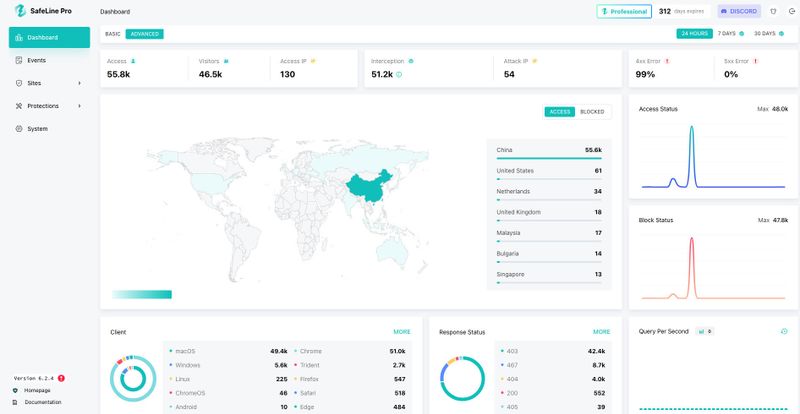When it comes to protecting your web applications from modern threats, a Web Application Firewall (WAF) is essential. Two options stand out depending on your deployment style and infrastructure needs: SafeLine WAF and AWS WAF.
In this post, we’ll walk through a practical comparison to help you decide which one is the better fit for your use case.
Overview
| Feature | SafeLine WAF | AWS WAF |
|---|---|---|
| Deployment | Self-hosted (Docker, VMs, etc.) | Cloud-native (AWS-only) |
| Traffic Model | Inline (reverse/transparent proxy) | Policy-based filtering via CloudFront/API Gateway |
| Detection Engine | Intelligent semantic analysis engine | Rule-based pattern matching |
| Customization | High – full control over config, plugins | Moderate – managed via AWS Console or APIs |
| Latency | Low (depends on server location) | Low (if integrated with AWS infra) |
| Integration | Works with any web stack (via proxy) | Best suited for AWS-native services |
| Logging | Local logs, syslog support, full visibility | CloudWatch integration, customizable metrics |
| Pricing | Free to start, with optional upgrades | Pay-per-request & per-rule charges |
Deployment Model
- SafeLine is installed directly on your infrastructure (bare-metal, VM, container). It acts as a reverse or transparent proxy, inspecting and filtering HTTP traffic in real-time.
- AWS WAF is a cloud-native solution tightly integrated with AWS services like CloudFront, ALB, and API Gateway. You apply WAF rules to these resources to filter inbound traffic.
Pros:
- SafeLine offers full visibility and control for teams that prefer on-premise or hybrid deployments.
- AWS WAF shines when your whole architecture is already built on AWS and you want to manage everything in one place.
Detection Capabilities
SafeLine leverages an intelligent semantic analysis engine that goes beyond signature or rule-based detection. This enables it to identify zero-day threats, logic-based attacks, and obfuscated payloads.
AWS WAF relies on managed rule groups or your custom rules (regex, IP sets, rate limiting, etc.). It's effective for known patterns and volumetric attacks, but less flexible for advanced evasion techniques.
Use Cases
| Scenario | Recommended WAF |
|---|---|
| Need full control or offline use | ✅ SafeLine |
| Already running on AWS infrastructure | ✅ AWS WAF |
| Require semantic detection of unknown threats | ✅ SafeLine |
| Need to secure global traffic via CloudFront CDN | ✅ AWS WAF |
| Looking for low-level tuning and log control | ✅ SafeLine |
Real-World Flexibility
SafeLine can be integrated with OpenResty/Nginx, existing proxies, or even API gateways like Kong/APISIX. Perfect for security labs, hybrid deployments, or internal enterprise networks.
AWS WAF works well if you're running a serverless or API-heavy app entirely on AWS. But it doesn’t support external (non-AWS) deployments.
Conclusion
Both SafeLine and AWS WAF offer solid protection, but they target different audiences:
Choose SafeLine if you want a self-hosted, intelligent, and highly customizable WAF that you fully control.
Choose AWS WAF if you're deeply integrated into the AWS ecosystem and want to manage everything in the cloud with less operational overhead.
Learn More
- SafeLine GitHub: github.com/chaitin/SafeLine
- SafeLine Docs: https://docs.waf.chaitin.com/
- SafeLine Community:https://discord.gg/dy3JT7dkmY
- AWS WAF Docs: docs.aws.amazon.com/waf
- AWF WAF GitHub: github.com/aws-solutions/aws-waf-security-automations




Top comments (0)